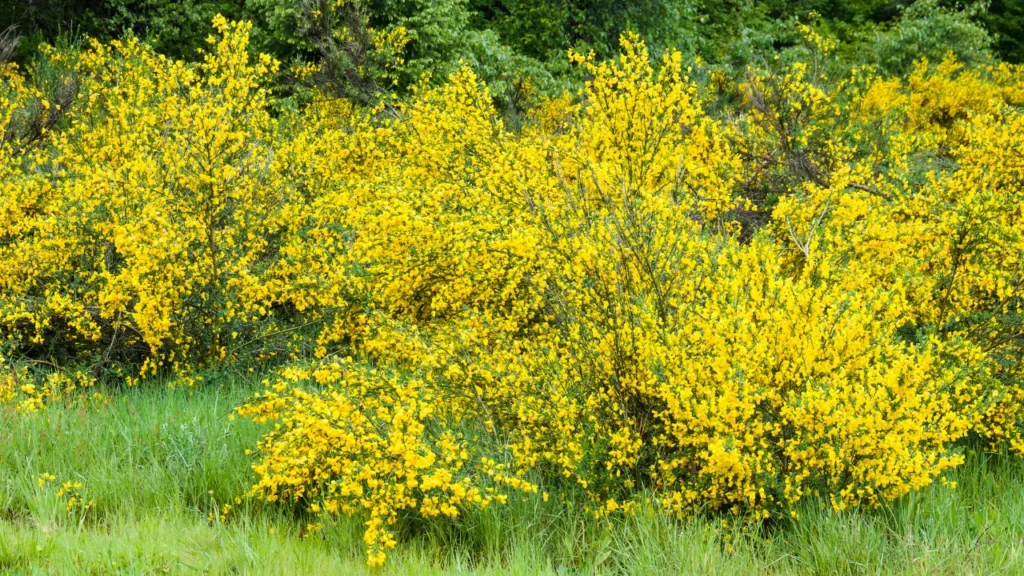There is a plant known as Scotch Broom, or Cytisus scoparius. Scotch Broom is indigenous to Western Europe. In recent times in the West, Scotch Broom has gained scientific and consumer attention for a number of purposes, including as a nootropic supplement. This page explores the properties of Scotch Broom, including its health advantages, ideal dosages, adverse effects, possible interactions with other substances, and responsible use. It offers a thorough description of the herb’s use as a cognitive enhancer.
You May Also Like:
Diamond CBD Gummies vs. Joy Organics CBD Gummies
CBD for Concentration: The Productivity Hack for Energy and Focus
Scotch Broom: Benefits, Dosage, Side Effects, Drug Interactions, And Other Important Information is an original (NootropicsPlanet) article.
Nature of Scotch Broom
The Fabaceae family includes the perennial shrub known as Scotch Broom, distinguished by its green, slender branches and vivid yellow blooms. It has been utilized historically for many different reasons, such as Broom manufacturing and conventional medicine. Alkaloids like sparteine and scoparine are among the bioactive substances found in Scotch Broom, and they play a role in the plant’s nootropic effects.
Health Benefits of Scotch Broom
While empirical evidence on the nootropic benefits of Scotch Broom is limited, the theoretical implications of its bioactive compounds suggest several, potential health benefits related to cognitive enhancement:
- Enhanced Memory and Learning: By modulating acetylcholine receptors, Scotch Broom could theoretically support memory formation and learning processes. Acetylcholine is essential for the encoding of new memories and the retrieval of existing ones.
- Improved Attention and Focus: The potential stimulatory effects on the central nervous system might help individuals achieve better focus and sustained attention on tasks, making it a subject of interest for those looking to improve productivity.
- Increased Alertness: Through its action on neurotransmitter systems, Scotch Broom may help combat fatigue and increase alertness, providing a natural boost to mental energy levels.

Chemistry of Scotch Broom
The plant known as Scotch Broom (Cytisus scoparius) is rich in bioactive chemicals, the most important of which are alkaloids, which have nootropic properties. The two most important alkaloids are scoparine and sparteine. The quinolizidine alkaloid sparteine plays a significant influence in how the plant interacts with human physiology.
Sparteine has an interesting chemistry; its bicyclic shape enables it to interact with different brain neurotransmitter receptors. Nicotinic acetylcholine receptors, which play a crucial role in regulating neuronal transmission, are thought to be the primary site of this interaction. Sparteine’s interaction with these receptors can change the kinetics of neurotransmitter uptake and release, especially acetylcholine, which is essential for memory, learning, and attention.
Scoparine, though less studied, also contributes to the plant’s pharmacological profile. Its chemical interactions with the body’s physiological systems further complement the effects initiated by sparteine, although the specific mechanisms and outcomes of these interactions require more scientific elucidation.
Physiological Mechanism of Action
The physiological mode of action of the alkaloids found in Scotch Broom, specifically sparteine, include the modulation of brain neurotransmitter systems. The interaction with nicotinic acetylcholine receptors is the main mechanism. The mechanism by which neurons communicate with one another, known as synaptic transmission, is greatly aided by these receptors.
Sparteine may imitate or intensify the effects of acetylcholine, a neurotransmitter that is directly related to memory and learning, when it binds to these receptors. This may lead to an increase in neuronal activity in brain regions linked to cognitive processes, which may improve memory, sharpen attention, and heighten alertness.
Furthermore, through their interaction with autonomic receptors, sparteine, and other bioactive chemicals in Scotch Broom have a physiological influence that includes modulating blood pressure and vascular tone. The vascular impact highlights the systemic significance of the alkaloids in Scotch Broom, even though it is secondary to the nootropic effects that some consumers are seeking.

Optimal Dosage of Scotch Broom
It is difficult to determine the ideal dosage of Scotch Broom for nootropic effects because there are few clinical research available. The plant or its extracts have been used in a wide range of dosages in traditional treatments. However, it is imperative to approach dosing cautiously due to the strong activity of its alkaloids, especially sparteine. Both medical doctors and herbalists frequently advise assessing tolerance by gradually increasing the dose from the lowest beginning point. Before beginning any new supplement regimen, especially one containing strong bioactive ingredients like those in Scotch Broom, speak with a healthcare expert.
Side Effects of Scotch Broom
The consumption of Scotch Broom, especially in high doses, can lead to several side effects, largely due to its alkaloid content. Sparteine, for instance, has been associated with symptoms such as nausea, dizziness, and headaches. Moreover, in significant quantities, it can exert a hypotensive effect, lowering blood pressure to potentially dangerous levels. The presence of other bioactive compounds can also contribute to gastrointestinal distress, including cramps and diarrhea.

Potential Substance Interactions
The potential interactions between Scotch Broom and other substances, especially pharmaceuticals, should be carefully considered. Due to its ability to alter blood pressure, it may negatively interact with antihypertensive medications, intensifying their effects and raising the possibility of hypotension. Moreover, its effects on neurotransmitter systems may make it difficult for psychotropic drugs like antidepressants and antipsychotics to work. When adding Scotch Broom to a supplement regimen, anyone using any kind of medicine should speak with their doctor first.
Best Responsible Use
Use Scotch Broom responsibly because of its powerful properties and bioactive components. This entails thinking about the wider ramifications of its use in addition to following advised dosages and keeping an eye out for any negative effects. Legal issues (because some alkaloids may be controlled substances) and environmental issues (since Scotch Broom is considered an invasive species in some areas) must also be considered.
Scotch Broom:
Conclusion
Use caution when pursuing these possible advantages to definitively verify the safety and effectiveness of Scotch Broom as a nootropic. A cautious and informed approach to its use is also required due to the balance between the health advantages and the potential for adverse effects, such as gastrointestinal distress and hypotension. Regardless of necessary precautions and cautiousness, there is evidence of Scotch Broom as helpful to health. It is packed with certain chemicals that lend themselves to positive interactions with various systems of the body. It has a distinctive chemical structure that makes it interface with neurotransmitters and other chemicals in the body very well. Its ability to support brain health is appealing and makes for some nootropic potential.

References:
- “Broom.” Retrieved from: https://www.drugs.com/npp/Broom.html
- “Scotch Broom- Uses, Side Effects, and More.” Retrieved from: https://www.webmd.com/vitamins/ai/ingredientmono-375/Scotch-Broom
- “Scotch Broom.” Retrieved from: https://www.rxlist.com/supplements/scotch_Broom.htm
Important Note: The information contained in this article is for general informational purposes only, and should not be construed as health or medical advice, nor is it intended to diagnose, prevent, treat, or cure any disease or health condition. Before embarking on any diet, fitness regimen, or program of nutritional supplementation, it is advisable to consult your healthcare professional in order to determine its safety and probable efficacy in terms of your individual state of health.
Regarding Nutritional Supplements Or Other Non-Prescription Health Products: If any nutritional supplements or other non-prescription health products are mentioned in the foregoing article, any claims or statements made about them have not been evaluated by the U.S. Food and Drug Administration, and such nutritional supplements or other health products are not intended to diagnose, treat, cure, or prevent any disease.


